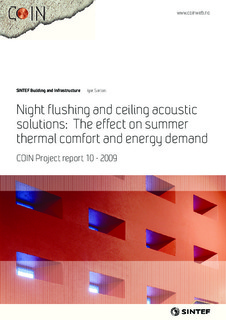| dc.contributor.author | Sartori, Igor | |
| dc.date.accessioned | 2016-09-27T13:15:33Z | |
| dc.date.available | 2016-11-18T16:59:01Z | |
| dc.date.issued | 2009 | |
| dc.identifier.isbn | 978-82-536-1142-6 | |
| dc.identifier.issn | 1891-1978 | |
| dc.identifier.uri | http://hdl.handle.net/11250/2421947 | |
| dc.description.abstract | The case analysed represents a standard size landscape office room in Oslo climate. The office envelope and system properties are in compliance with the TEK (2007). The study concentrates on the thermal comfort conditions in summer and two cooling systems are considered, one representing an idealised room cooling system and one representing a typical ventilation cooling system. Three acoustic solutions are considered: conventional horizontal panels, micro perforated resonant box, and vertical baffles.
With the idealised room cooling system, micro perforated resonant absorbers covering the entire ceiling requires the same room cooling energy as the conventional insulating panels covering 30% of the ceiling. Vertical baffles with a sound absorbing area equivalent to fully covering the ceiling area are expected to have the same effect on room cooling energy as horizontally mounted panels covering 40% of the ceiling area. However, when accounting for room cooling energy and fans operation at day and night the differences between the acoustic solutions are levelled off, and the overall effect is small compared to the effect of using or not using the night flushing.
With the ventilation cooling system, night flushing proved sufficient to fulfil the legal comfort requirements on operative temperature, without use of direct room cooling. Concerning both the energy demand and the thermal comfort conditions, there is no significant difference in the performance of the various acoustic solutions.
A critical look at the results lead to the conclusion that the framework for calculations (NS3031, 2007) was suboptimal for estimating the effect of concrete’s thermal mass. A more appropriate approach would require a finer description of the ventilation system and its control strategy both at day and night, as well as of the internal load and solar shading profiles. | |
| dc.language.iso | eng | |
| dc.publisher | SINTEF Building and Infrastructure | |
| dc.relation.ispartofseries | COIN Project report;10 | |
| dc.subject | Energy efficiency | |
| dc.subject | Thermal comfort conditions | |
| dc.subject | Acoustic solutions | |
| dc.title | Night flushing and ceiling acoustic solutions: The effect on summer thermal comfort and energy demand : COIN P5 Energy efficiency comfort, Sub P5.2 Comfort | |
| dc.title.alternative | Night flushing and ceiling acoustic solutions: The effect on summer thermal comfort and energy demand : COIN P5 Energy efficiency comfort, Sub P5.2 Comfort | |
| dc.type | Research report | |
| dc.date.updated | 2016-09-27T13:15:33Z | |
| dc.rights.holder | © 2009 SINTEF Building and Infrastructure | |
| dc.subject.nsi | VDP::Technology: 500 | |
| dc.identifier.cristin | 1268202 | |
